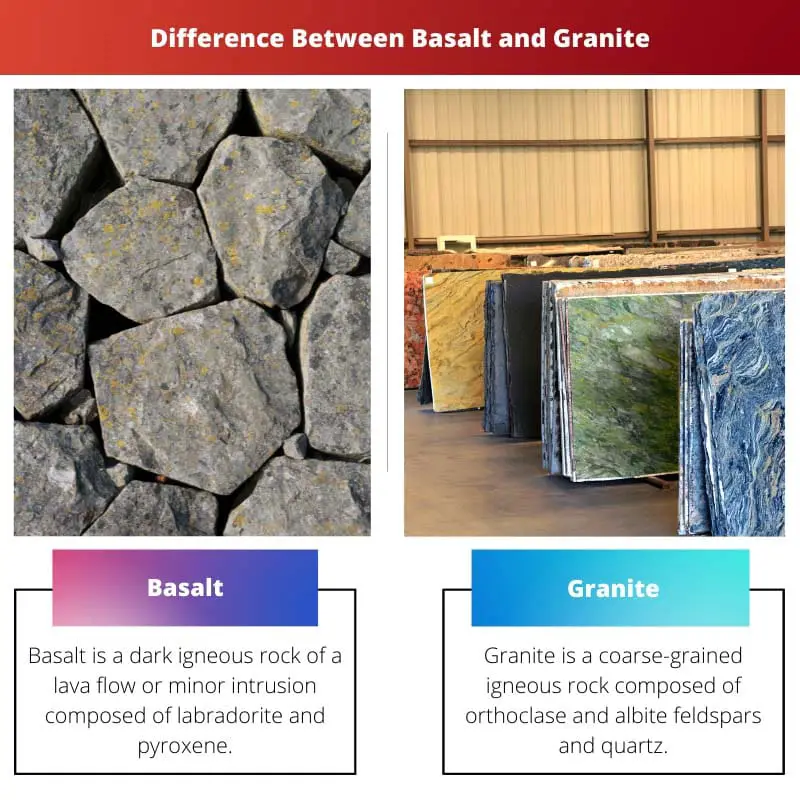Igneous Rock is formed from the crystallization of molten rock material. There are two types: Intrusive Igneous Rock that solidifies below the earth’s surface, and large crystals are formed due to slow colling.
The other type of Igneous Rock is Extrusive which erupts onto the surface, where they cool quickly to form small crystals. Basalt is an igneous or volcanic rock produced by the rapid cooling of lava rich in magnesium and iron.
It is formed at the surface where it will Barden from lava. Granite is a coarse- or medium-grained intrusive igneous rock with a felsic composition.
It makes up the bulk of major mountain ranges and the core of continents worldwide.
Key Takeaways
- Basalt is a fine-grained volcanic rock formed from lava flows with a dark, dense appearance; granite is a coarse-grained igneous rock formed from the slow cooling of magma with a lighter, more varied appearance.
- Basalt is dark grey to black and has a uniform texture; granite can have a wide range of colours, from pink to grey to black, and a variable texture with visible crystals.
- Basalt is harder than granite and has a higher density; granite is less dense and can be more easily shaped and polished.
Basalt vs. Granite
When earth’s lava changes and solidifies into long lasting, widespread, and strong dark, hard crust, finely grained rocks is called Basalt. Granite is a widespread aesthetically pleasing rock having quartz, feldspar, and mica as its main constituents. It is used in construction and kitchen slabs.

Comparison Table
| Parameter of Comparison | Basalt | Granite |
|---|---|---|
| Definition | Basalt is a dark igneous rock of a lava flow or minor intrusion composed of labradorite and pyroxene. | Granite is a coarse-grained igneous rock composed of orthoclase and albite feldspars and quartz. |
| Composition | Basalt is composed of Mafic. | Granite is composed of Felsic. |
| Surface Location | Basalt is an Extrusive Igneous Rock. | Granite is an Intrusive Igneous Rock. |
| Formation Time | Basalt takes days or months for the formation. | Granite takes millions of years for their formation. |
| Distribution | It is common on most silicate terrestrial planetary bodies. | It is only found on Earth. |
| Associated Crust | Basalt is found in continental as well as oceanic crusts. | Granite is found only in the continental crusts. |
What is Basalt?
Basalt is a fine-grained, dense, dark-colored extrusive igneous rock composed of plagioclase and pyroxene minerals. It is made from the rapid cooling of lava rich in iron and magnesium exposed very near the surface of a terrestrial planet or a moon.
Geologists observe the eruption of basalt lava at about 20 volcanoes per year, and more than 90% of all volcanic rock on Earth is basalt. Basalt is an igneous rock aphanitic (fine-grained) relatively low in silica and alkali metals.
This igneous rock consists of minerals such as porphyritic phenocrysts(containing larger crystals) formed before the extrusion that brought the magma to the surface, embedded in a finer-grained matrix. These phenocrysts are of augite, olivine, or a calcium-rich plagioclase, which have the highest melting temperatures of the typical minerals that can crystallize from the melt and are the first to form solid crystals.
Basalt is used for a huge variety of purposes. Basalt is cut into dimension stone.
The lean basalt slabs are cut and polished for building veneer, monuments, floor tiles, and other stone objects. It is also crushed for use as an aggregate in construction projects.
These crushed rocks are used for road bases, concrete aggregate, railroad ballast, filter stone in drain fields, asphalt pavement aggregate, and many other purposes.

What is Granite?
Granite is a light-colored igneous rock with grains large enough to be visible to the unaided eye. It is formed from the slow solidification of magma below the Earth’s surface.
It comprises quartz and feldspar(rock-forming minerals) with minor amounts of mica, amphiboles, and other minerals. Basalt sometimes also contains vesicles.
It is formed when dissolved gases bubble out of the magma as it decompresses during its approach to the surface, and the erupted lava then solidifies before the gases can escape. The rock is described as scoria when vesicles make up a substantial fraction of the volume of the rock.
Granite has been used for thousands of years in exterior and interior applications. Rough-cut and polished granite are used in buildings, monuments, bridges, paving, and other exterior projects.
For the indoor project, polished granite slabs and tiles are used in stair treads, countertops, tile floors, and many other practical and decorative features. It is also used as an aggregate of crushed stone. In the said form, it is used as a base material at construction sites, as an aggregate in road construction, foundations, railroad ballast, and anywhere a crushed stone is useful as fill.

Main Differences Between Basalt and Granite
- Basalt is a dense, dark, fine-grained igneous rock of a lava flow or minor intrusion composed of labradorite and pyroxene. Granite is a coarse-grained igneous rock composed of orthoclase, albite feldspars, and quartz.
- Basalt is darker colored and is composed of mafic. On the other hand, granite is light-colored and is composed of felsic.
- Basalt is an extrusive igneous rock that erupts onto the surface, where they cool quickly to form small crystals. And granite is an intrusive igneous rock that solidifies below the earth’s surface, and large crystals are formed due to slow colling.
- Basalt takes lesser time to formulate, whereas granite takes millions of years.
- Basalt is common on most silicate terrestrial planetary bodies and is found in oceanic and continental crusts. Whereas granite is only found on Earth and it is found only around the continental crusts.
- Basalt has columnal planes, whereas granite has horizontal planes.



